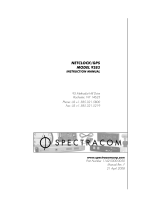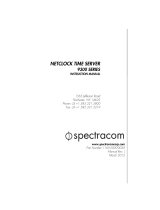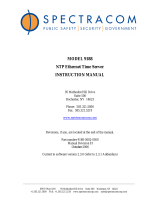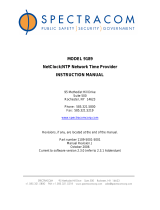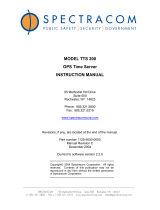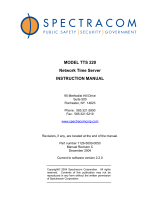Page is loading ...

NETCLOCK ETHERNET
TIME SERVER MODEL 9288
INSTRUCTION MANUAL
95 Methodist Hill Drive
Rochester, NY 14623
Phone: US +1.585.321.5800
Fax: US +1.585.321.5219
www.spectracomcorp.com
Part Number 1150-5000-0050
Manual Rev. F
21 April 2008

Copyright © 2007 Spectracom Corporation. The contents of this publication may not be reproduced
in any form without the written permission of Spectracom Corporation. Printed in USA.
Specifications subject to change or improvement without notice.
Spectracom, NetClock, Ageless, TimeGuard, TimeBurst, TimeTap, LineTap, MultiTap, VersaTap, and
Legally Traceable Time are Spectracom registered trademarks. All other products are identified by
trademarks of their respective companies or organizations. All rights reserved.

SPECTRACOM LIMITED WARRANTY
LIMITED WARRANTY
Spectracom warrants each new product manufactured and sold by
it to be free from defects in software, material, workmanship, and
construction, except for batteries, fuses, or other material normally
consumed in operation that may be contained therein AND AS
NOTED BELOW, for five years after shipment to the original
purchaser (which period is referred to as the “warranty period”).
This warranty shall not apply if the product is used contrary to the
instructions in its manual or is otherwise subjected to misuse,
abnormal operations, accident, lightning or transient surge, repairs
or modifications not performed by Spectracom.
The GPS receiver is warranted for one year from date of shipment
and subject to the exceptions listed above. The power adaptor, if
supplied, is warranted for one year from date of shipment and
subject to the exceptions listed above.
THE ANALOG CLOCKS ARE WARRANTED FOR ONE YEAR
FROM DATE OF SHIPMENT AND SUBJECT TO THE EXCEPTIONS
LISTED ABOVE.
THE TIMECODE READER/GENERATORS ARE WARRANTED FOR
ONE YEAR FROM DATE OF SHIPMENT AND SUBJECT TO THE
EXCEPTIONS LISTED ABOVE.
The Rubidium oscillator, if supplied, is warranted for two years from
date of shipment and subject to the exceptions listed above.
All other items and pieces of equipment not specified above,
including the antenna unit, antenna surge suppressor and antenna
pre-amplifier are warranted for 5 years, subject to the exceptions
listed above.
WARRANTY CLAIMS
Spectracom’s obligation under this warranty is limited to in-factory
service and repair, at Spectracom’s option, of the product or the
component thereof, which is found to be defective. If in
Spectracom’s judgment the defective condition in a Spectracom
product is for a cause listed above for which Spectracom is not
responsible, Spectracom will make the repairs or replacement of
components and charge its then current price, which buyer agrees
to pay.
Spectracom shall not have any warranty obligations if the
procedure for warranty claims is not followed. Users must notify
Spectracom of the claim with full information as to the claimed
defect. Spectracom products shall not be returned unless a return
authorization number is issued by Spectracom.
Spectracom products must be returned with the description of the
claimed defect and identification of the individual to be contacted
if additional information is needed. Spectracom products must be
returned properly packed with transportation charges prepaid.
Shipping expense: Expenses incurred for shipping Spectracom
products to and from Spectracom (including international customs
fees) shall be paid for by the customer, with the following
exception. For customers located within the United States, any
product repaired by Spectracom under a “warranty repair” will be
shipped back to the customer at Spectracom’s expense unless
special/faster delivery is requested by customer.
Spectracom highly recommends that prior to returning equipment for
service work, our technical support department be contacted to
provide trouble shooting assistance while the equipment is still
installed. If equipment is returned without first contacting the support
department and “no problems are found” during the repair work,
an evaluation fee may be charged.
EXCEPT FOR THE LIMITED WARRANTY STATED ABOVE,
SPECTRACOM DISCLAIMS ALL WARRANTIES OF ANY KIND
WITH REGARD TO SPECTRACOM PRODUCTS OR OTHER
MATERIALS PROVIDED BY SPECTRACOM, INCLUDING
WITHOUT LIMITATION ANY IMPLIED WARRANTY OR
MERCHANTABILITY OR FITNESS FOR A PARTICULAR PURPOSE.
Spectracom shall have no liability or responsibility to the original
customer or any other party with respect to any liability, loss, or
damage caused directly or indirectly by any Spectracom product,
material, or software sold or provided by Spectracom, replacement
parts or units, or services provided, including but not limited to any
interruption of service, excess charges resulting from malfunctions of
hardware or software, loss of business or anticipatory profits
resulting from the use or operation of the Spectracom product or
software, whatsoever or howsoever caused. In no event shall
Spectracom be liable for any direct, indirect, special or
consequential damages whether the claims are grounded in
contract, tort (including negligence), or strict liability.
EXTENDED WARRANTY COVERAGE
Extended warranties can be purchased for additional periods
beyond the standard five-year warranty. Contact Spectracom no
later than the last year of the standard five-year warranty for
extended coverage.
SPECTRACOM 95 Methodist Hill Drive Rochester, NY 14623
+1.585.321.5800 FAX: +1.585.321.5218 www.spectracomcorp.com [email protected]

This equipment has been tested and found to comply
with the limits for a Class B digital device, pursuant to
Part 15 of the FCC Rules. These limits are designed to
provide reasonable protection against harmful
interference in a residential installation. This equipment
generates, uses, and can radiate radio frequency
energy and, if not installed and used in accordance
with the instructions, may cause harmful interference to
radio communications. However, there is no guarantee
that interference will not occur in a particular
installation. If this equipment does cause harmful
interference to radio or television reception, which can
be determined by turning the equipment off and on, the
user is encouraged to try to correct the interference by
one or more of the following measures:
-- Reorient or relocate the receiving antenna.
-- Increase the separation between the equipment and
receiver.
-- Connect the equipment into an outlet on a circuit
different from that to which the receiver is connected.
-- Consult the dealer or an experienced radio/TV
technician for help.

Spectracom Corporation Model 9288
NetClock Ethernet Time Server Instruction Manual iii
Table of Contents
1 GENERAL INFORMATION ..................................................................................1-1
1.1 Introduction................................................................................................................................................... 1-1
1.2 Warranty Information and Customer Support............................................................................................... 1-2
1.3 Inspection..................................................................................................................................................... 1-3
1.3.1 Inventory....................................................................................................................................................... 1-3
1.4 Specifications............................................................................................................................................... 1-4
1.4.1 RS-232 Serial Setup Interface Port.............................................................................................................. 1-4
1.4.2 10/100 Ethernet Port.................................................................................................................................... 1-4
1.4.3 Protocols Supported..................................................................................................................................... 1-4
1.4.4 RS-232 Communication Port........................................................................................................................ 1-5
1.4.5 RS-485 Input/Output.................................................................................................................................... 1-5
1.4.6 Front Panel LED Indicators..........................................................................................................................1-5
1.4.7 Relay Outputs............................................................................................................................................... 1-5
1.4.8 1PPS Input................................................................................................................................................... 1-6
1.4.9 Input Power.................................................................................................................................................. 1-6
1.4.10 Mechanical and Environmental....................................................................................................................1-6
2 INSTALLATION...................................................................................................2-1
2.1 Summary...................................................................................................................................................... 2-1
2.2 Required Tools and Cables.......................................................................................................................... 2-3
2.3 Power and Ground Connection.................................................................................................................... 2-3
2.4 Rack Mounting .............................................................................................................................................2-5
2.5 Ethernet Network Cabling ............................................................................................................................ 2-5
2.5.1 Optional CNC3000 Cable Kit........................................................................................................................2-5
2.6 Remote Port and Serial Comm Port Output Pin-outs and Wiring................................................................. 2-6
2.6.1 Serial Comm Ports....................................................................................................................................... 2-6
2.6.2 RS-485 Remote Port.................................................................................................................................... 2-7
2.6.3 Remote Output Usage.................................................................................................................................. 2-8
2.6.4 RS-485 Guidelines and Cable Selection...................................................................................................... 2-9
2.6.5 Connection Method...................................................................................................................................... 2-9
2.6.6 Termination................................................................................................................................................ 2-13
3 PRODUCT CONFIGURATION .............................................................................3-1
3.1 Network Configuration with DHCP............................................................................................................... 3-2
3.2 Initial Network Configuration ........................................................................................................................ 3-5
3.2.1 Using HyperTerminal to Connect to the Netclock......................................................................................... 3-5
3.2.2 Initial Network Setup ..................................................................................................................................3-10
3.2.3 Default and Recommended Configurations................................................................................................ 3-13
3.3 Issuing the HALT Command before Removing Power............................................................................... 3-14
3.3.1 Issuing the HALT Command through the Web UI...................................................................................... 3-14
3.3.2 Issuing the HALT Command through the CLI............................................................................................. 3-16
3.3.3 Issuing the HALT Command through SNMP.............................................................................................. 3-17
3.4 Product Configuration using the WEB UI ................................................................................................... 3-20
3.4.1 Configuring NTP......................................................................................................................................... 3-20
3.4.2 NTP Support............................................................................................................................................... 3-28
3.4.3 Configuring the Interface............................................................................................................................ 3-29
3.4.4 Sysplex Timing........................................................................................................................................... 3-33
3.4.5 Configuring the System: SNMP.................................................................................................................. 3-34
3.4.6 Configuring Alarms..................................................................................................................................... 3-37

Model 9288 Spectracom Corporation
NetClock Ethernet Time Server Instruction Manual iv
3.4.7 Configuring System Time and Local Clocks............................................................................................... 3-38
3.4.8 Activating System Options and Rolling Back Updates............................................................................... 3-43
3.4.9 Rebooting the System................................................................................................................................ 3-45
3.4.10 Configuring System Holdover..................................................................................................................... 3-46
3.4.11 Serial Time Code Setup............................................................................................................................. 3-48
3.4.12 Configuring System Logs........................................................................................................................... 3-49
3.4.13 Configuring and Testing Relays................................................................................................................. 3-50
3.4.14 Configuring Network Security..................................................................................................................... 3-58
3.4.15 If You Cannot Access a Secure NetClock.................................................................................................. 3-70
3.4.16 Configuring User Accounts.........................................................................................................................3-71
3.4.17 Configuring SNMP v1, v2, and v3.............................................................................................................. 3-74
3.4.18 Configuring LDAP and RADIUS................................................................................................................. 3-78
3.4.19 Configuring IPSec ......................................................................................................................................3-82
3.4.20 Logs and Status Reporting......................................................................................................................... 3-93
4 OPERATION .......................................................................................................4-1
4.1 Front Panel................................................................................................................................................... 4-1
4.1.1 Status Indicator............................................................................................................................................ 4-1
4.2 Rear Panel................................................................................................................................................... 4-3
4.2.1 Event and Alarm Relay Outputs................................................................................................................... 4-4
4.3 Leap Second occurrence ............................................................................................................................. 4-5
4.3.1 Reasons for a Leap Second Correction....................................................................................................... 4-5
4.3.2 Leap Second Alert Notification..................................................................................................................... 4-5
4.3.3 Sequence of a Leap Second Correction Being Applied ............................................................................... 4-6
5 SERIAL DATA FORMATS .....................................................................................5-1
5.1 Format 0....................................................................................................................................................... 5-1
5.2 Format 1....................................................................................................................................................... 5-2
5.3 Format 2....................................................................................................................................................... 5-3
5.4 Format 3....................................................................................................................................................... 5-5
5.5 Format 4....................................................................................................................................................... 5-6
5.6 Format 7....................................................................................................................................................... 5-7
5.7 Format 8....................................................................................................................................................... 5-8
6 SERIAL SETUP INTERFACE COMMANDS.............................................................6-1
6.1 time .............................................................................................................................................................. 6-1
6.2 reboot........................................................................................................................................................... 6-1
6.3 log ................................................................................................................................................................ 6-2
6.4 option ........................................................................................................................................................... 6-2
6.5 ltc.................................................................................................................................................................. 6-2
6.6 net................................................................................................................................................................ 6-3
6.7 sys................................................................................................................................................................ 6-3
6.8 ser................................................................................................................................................................ 6-3
6.9 rem............................................................................................................................................................... 6-4
6.10 frq................................................................................................................................................................. 6-4
7 OPTIONS............................................................................................................7-1
8 LICENSE NOTICES ..............................................................................................8-1

Spectracom Corporation Model 9288
NetClock Ethernet Time Server Instruction Manual v
List of Figures
Figure 2-1: Serial Port Pin Configuration .................................................................................................................. 2-6
Figure 2-2: Remote Outputs...................................................................................................................................... 2-7
Figure 2-3: RS-485 Output........................................................................................................................................ 2-7
Figure 2-4: One-Way Bus Installation..................................................................................................................... 2-10
Figure 2-5: Split Bus Configuration......................................................................................................................... 2-10
Figure 2-6: Wire Strain Relief.................................................................................................................................. 2-11
Figure 2-7: TimeView RS-485 Interface.................................................................................................................. 2-11
Figure 2-8: Model 8179T TimeTap RS-485 Interface.............................................................................................. 2-12
Figure 2-9: Model 9288 RS-485 Interface............................................................................................................... 2-12
Figure 2-10: TimeBurst RS-485 Interface............................................................................................................... 2-13
Figure 3-1: Entering to the Configuration in the Web UI ........................................................................................... 3-1
Figure 3-2: Web Browser User Interface (Web UI)................................................................................................... 3-2
Figure 3-3: Security – Network Screen (1 of 2)......................................................................................................... 3-3
Figure 3-4: Security – Network Screen (2 of 2)......................................................................................................... 3-4
Figure 3-5: Establishing a New Terminal Connection............................................................................................... 3-5
Figure 3-6: Connecting to the Computer’s Serial Port............................................................................................... 3-6
Figure 3-7: Configuring the Serial Port Connection Properties................................................................................. 3-6
Figure 3-8: Spectracom NetClock Command Line Interface (CLI)............................................................................ 3-7
Figure 3-9: Available CLI Commands....................................................................................................................... 3-8
Figure 3-10: Serial Port Pin Configuration ................................................................................................................ 3-9
Figure 3-11: Net Commands................................................................................................................................... 3-10
Figure 3-12: Prompt for Initial Configuration Values in the CLI............................................................................... 3-10
Figure 3-13: Initial Configuration using the CLI....................................................................................................... 3-11
Figure 3-14: Successful Completion of Network Configuration............................................................................... 3-12
Figure 3-15: System Reboot/Halt Screen (1 of 3).................................................................................................... 3-14
Figure 3-16: System Reboot/Halt Screen (2 of 3).................................................................................................... 3-15
Figure 3-17: System Reboot/Halt Screen (3 of 3).................................................................................................... 3-15
Figure 3-18: Command Line Interface (CLI) ............................................................................................................ 3-16
Figure 3-19: Halting the System from the CLI.......................................................................................................... 3-16
Figure 3-20: Rebooting the System from the CLI..................................................................................................... 3-17
Figure 3-21: Reboot MIB Location Options (SNMP)................................................................................................ 3-17
Figure 3-22: Rebooting the Unit through SNMP....................................................................................................... 3-18
Figure 3-23: Halting the Unit through SNMP............................................................................................................ 3-19
Figure 3-24: Successful Halt.................................................................................................................................... 3-19
Figure 3-25: Web UI Primary Menu ........................................................................................................................ 3-20
Figure 3-26: Web UI NTP Menu............................................................................................................................... 3-20
Figure 3-27: NTP General Screen........................................................................................................................... 3-21
Figure 3-28: NTP References Screen (1 of 2).......................................................................................................... 3-23
Figure 3-29: NTP References Screen (2 of 2).......................................................................................................... 3-24
Figure 3-30: NTP Symmetrical Keys Screen............................................................................................................ 3-25
Figure 3-31: NTP Autokey Screen........................................................................................................................... 3-26
Figure 3-32: Statistics FTP Screen.......................................................................................................................... 3-27
Figure 3-33: NTP Status Screen.............................................................................................................................. 3-28
Figure 3-34: Interface Menu.................................................................................................................................... 3-29
Figure 3-35: Interface Serial Port 1 Screen............................................................................................................. 3-30
Figure 3-36: Interface Remote Port 1 Screen......................................................................................................... 3-31
Figure 3-37: Interface Set to Defaults Screen......................................................................................................... 3-32
Figure 3-38: Configuring Serial Port 1 for Sysplex Timing....................................................................................... 3-33

Model 9288 Spectracom Corporation
NetClock Ethernet Time Server Instruction Manual vi
Figure 3-39: System Menu......................................................................................................................................3-34
Figure 3-40: System SNMP Screen........................................................................................................................ 3-35
Figure 3-41: Spectracom’s MIB............................................................................................................................... 3-36
Figure 3-42: System Alarm Screen......................................................................................................................... 3-37
Figure 3-43: System Time Screen .......................................................................................................................... 3-38
Figure 3-44: Local System Clocks Screen (1 of 2).................................................................................................. 3-39
Figure 3-45: Local System Clock Screen (2 of 2).................................................................................................... 3-40
Figure 3-46: System Update Screen....................................................................................................................... 3-44
Figure 3-47: System Reboot Screen....................................................................................................................... 3-45
Figure 3-48: System Holdover Screen.................................................................................................................... 3-46
Figure 3-49: Serial Time Code Setup Screen......................................................................................................... 3-48
Figure 3-50: System Log Configuration Screen...................................................................................................... 3-49
Figure 3-51: Relay Menu......................................................................................................................................... 3-50
Figure 3-52: Relay Output Screen .......................................................................................................................... 3-51
Figure 3-53: Event Timer Relay Screen.................................................................................................................. 3-52
Figure 3-54: Edit/View Event Timers....................................................................................................................... 3-53
Figure 3-55: Relay Current Event Scheduler Screen.............................................................................................. 3-55
Figure 3-56: Relay Reset ALL Event Timers Screen ..............................................................................................3-56
Figure 3-57: Test Relays Screen ............................................................................................................................ 3-57
Figure 3-58: Security Menu...................................................................................................................................... 3-58
Figure 3-59: Security Network Screen (1 of 2)......................................................................................................... 3-59
Figure 3-60: Security Network Screen (2 of 2)......................................................................................................... 3-60
Figure 3-61: Security SSH Screen (1 of 2)............................................................................................................... 3-61
Figure 3-62: Security SSH Screen (2 of 2)............................................................................................................... 3-62
Figure 3-63: Security HTTPS Screen (1 of 2).......................................................................................................... 3-67
Figure 3-64: Security HTTPS Screen (2 of 2).......................................................................................................... 3-68
Figure 3-65: Security User Account Screen............................................................................................................. 3-71
Figure 3-66: Security User Account Screen (Assigning Privileges) ......................................................................... 3-73
Figure 3-67: SNMP Security Screen (1 of 3)............................................................................................................ 3-74
Figure 3-68: SNMP Security Screen (2 of 3)............................................................................................................ 3-75
Figure 3-69: SNMP Security Screen (3 of 3)............................................................................................................ 3-76
Figure 3-70: Security LDAP General Screen........................................................................................................... 3-77
Figure 3-71: Security LDAP Client Configuration Screen (1 of 2)............................................................................ 3-78
Figure 3-72: Security LDAP Client Configuration Screen (2 of 2)............................................................................ 3-79
Figure 3-73: Security RADIUS General Screen....................................................................................................... 3-80
Figure 3-74: Security RADIUS Client Configuration Screen ....................................................................................3-81
Figure 3-75: IPSEC IKE SA Configuration Screen (1 of 2) ...................................................................................... 3-83
Figure 3-76: IPSEC IKE SA Configuration Screen (2 of 2) ...................................................................................... 3-84
Figure 3-77: IPSec General Screen......................................................................................................................... 3-87
Figure 3-78: IPSec Manual SA Configuration (1 of 2).............................................................................................. 3-89
Figure 3-79: IPSec Manual SA Configuration (2 of 2).............................................................................................. 3-90
Figure 3-80: IPSec General Screen......................................................................................................................... 3-91
Figure 3-81: Status and Log Menu.......................................................................................................................... 3-93
Figure 3-82: Alarm Log Screen............................................................................................................................... 3-94
Figure 3-83: Authorization Log Screen ................................................................................................................... 3-95
Figure 3-84: Event Log Screen............................................................................................................................... 3-96
Figure 3-85: Journal Log Screen............................................................................................................................. 3-97
Figure 3-86: NTP Log Screen................................................................................................................................. 3-98
Figure 3-87: IKE Log Screen.................................................................................................................................... 3-99
Figure 3-88: Operational Log Screen.................................................................................................................... 3-100
Figure 3-89: System Log Screen .......................................................................................................................... 3-101

Spectracom Corporation Model 9288
NetClock Ethernet Time Server Instruction Manual vii
Figure 3-90: Update Log Screen........................................................................................................................... 3-102
Figure 3-91: System Status Screen (1 of 2).......................................................................................................... 3-103
Figure 3-92: System Status Screen (2 of 2).......................................................................................................... 3-104
Figure 4-1: Front Panel.............................................................................................................................................4-1
Figure 4-2: NetClock Rear Panel Detail.................................................................................................................... 4-3
Figure 4-3: Event and Alarm Relay Contacts............................................................................................................ 4-4

Model 9288 Spectracom Corporation
NetClock Ethernet Time Server Instruction Manual viii
Underwriters Laboratory (UL) has not tested the performance or
reliability of the Global Positioning System (GPS) hardware, operating
software, or other aspects of this product. UL has only tested for fire,
shock, or casualties as outlined in UL’s Standard(s) for Safety for
Information Technology Equipment, UL60950-1. UL Certification does
not cover the performance or reliability of the GPS hardware and GPS
operating software.
UL MAKES NO REPRESENTATIONS, WARRANTIES, OR CERT-
IFICATIONS WHATSOEVER REGARDING THE PERFORMANCE
OR RELIABILITY OF ANY GPS RELATED FUNCTIONS OF THIS
PRODUCT.

Spectracom Corporation Model 9288
NetClock Ethernet Time Server Instruction Manual 1
-
1
1 General Information
Spectracom Corporation is a leading manufacturer of precise time-keeping devices used to
synchronize critical operations. Our products provide accurate, reliable, Legally Traceable
Time™ across your networks. The Spectracom 9200 series NetClock™ is a direct response to
customer needs for affordable time synchronization equipment that includes a variety of
necessary and widely used security, authentication, and networking features.
1.1 Introduction
The Model 9288 NetClock Ethernet Time Server time server provides synchronized timing using
Network Time Protocol (NTP). The NetClock meets or exceeds the National Emergency
Numbers Association (NENA) master clock standard and is ideally suited for delivering world-
wide, split-second timing to mission critical systems.
The 9288 uses the Linux v2.6 operating system and features a high-speed processor. A variety
of time code outputs are included to meet the requirements of numerous systems, including a
10/100 Base-T LAN port, an RS-232 serial port, and an RS-485 data bus port. Alarm outputs
and programmable timer outputs are also provided. The NetClock allows users to accurately
time stamp video surveillance systems, access points, card readers, time clocks, and alarm
systems to provide necessary evidence and validation of events.
The 9200 series’ new standard security features, which can be enabled and disabled by the
user, include Secure Shell (SSH), Secure Copy Protocol (SCP), and Secure File Transfer
Protocol (SFTP). Enhanced security features include Secure Sockets Layer (SSL) and SNMP
v1, v2, and v3 with host access restriction. The NetClock supports IPv4, IPv6, and centralized
user authentication (LDAP/Active Directory, RADIUS). NTP capabilities include peering,
Stratum 2, and Autokey.
The NetClock can be configured and its reports accessed through a Web User Interface (Web
UI). A Command Line Interface (CLI) is also provided for initial product configuration through
the serial setup port. Once configured, the NetClock can be accessed, under appropriate
security policies, anywhere within a network. The product features browser-based remote
diagnostics and control as well as Flash memory for remote software upgrades. A 10/100 Mbps
Ethernet LAN port provides support for Network Time Protocol (NTP) over a variety of platforms,
including Windows 2003, 2000, and XP, Cisco, UNIX, Linux, and more. Remote control and
monitoring can also be performed through SNMP and Telnet.
The NetClock also includes ancillary hardware.

Model 9288 Spectracom Corporation
NetClock Ethernet Time Server Instruction Manual 1-2
1.2 Warranty Information and Customer Support
Warranty information is found on the leading pages of this manual.
Spectracom constantly strives to improve its products. We greatly appreciate any and all
customer feedback.
Technical support is available by telephone at 585.321.5800. Please direct any comments or
questions regarding application, operation, or service to Spectracom’s Customer Service
Department. Customer Service is available Monday through Friday from 8:00 a.m. to 5:00 p.m.
EST, excluding holidays.
Product support is also available by e-mail. Questions regarding equipment, operation, and
applications may be e-mailed to Spectracom Sales Support at:
For repairs and technical support, questions may be e-mailed to Spectracom Technicians at:
Visit Spectracom’s web page for product information, application notes, and upgrade notices as
they become available:
http://www.spectracomcorp.com/
Please contact Customer Service before returning any equipment Spectracom. Customer
Service must provide you with a Return Material Authorization Number (RMA#) prior to
shipment. When contacting Customer Service, please be prepared to provide your equipment
serial number(s) and a description of the failure symptoms or issues you would like resolved.
Freight to Spectracom is to be prepaid by the customer.
Once you have obtained the RMA number, ship your equipment to the following address:
Spectracom Corporation
Repair Department, RMA# xxxxx
95 Methodist Hill Drive
Rochester, NY 14623

Spectracom Corporation Model 9288
NetClock Ethernet Time Server Instruction Manual 1
-
3
1.3 Inspection
On receipt, carefully examine the carton and its contents.
CAUTION: Electronic equipment is sensitive to Electrostatic Discharge
(ESD). Observe all ESD precautions and safeguards when
handling Spectracom equipment.
Verify that all material ordered has been received by checking the carton contents against the
packing list. If there is a discrepancy, please contact Spectracom Customer Service at US
585.321.5800. If there is damage to the carton resulting in damage to the unit, contact the
carrier immediately. Retain the carton and packing materials in the event the carrier wishes to
witness the shipping damage. Failing to report shipping damaging immediately may forfeit any
claim against the carrier. In addition, notify Spectracom Corporation of shipping damage or
shortages in order to obtain a replacement or repair services.
NOTE: If equipment is returned to Spectracom, it must be shipped in its original packing
material. Save all packaging material for this purpose.
1.3.1 Inventory
Your Spectracom time server package ships with the following components:
□
□
Unit
□
□
User manual
□
□
CE/UL-approved power supply for international use
□
□
Standard DB9F to DB9M RS-232 cable pinned as straight thru (used for initial configuration)
□
□
AC power cord
□
□
Rack-mount kit
□
□
Rubber footpads for desktop installation
□
□
3-pin terminal block connector for RS-485 connections
□
□
10-pin terminal block connector
□
□
Jeweler’s type screwdriver (for tightening the screws on the terminal blocks)
□
□
Terminating Resistors, 120Ω

Model 9288 Spectracom Corporation
NetClock Ethernet Time Server Instruction Manual 1-4
1.4 Specifications
NOTE: The specifications listed herein are based on “standard” operation with the unit
synchronized through the RS-485 input.
1.4.1 RS-232 Serial Setup Interface Port
Function: Accepts commands to locally configure the IP network parameters
for initial connectivity. Also used as the interface to the dial-out
modem (Option 03).
Connector: DB9 female, pin assignments conform to EIA/TIA-574 standard,
data communication equipment.
Character structure: ASCII, 9600 baud, 1 start, 8 data, 1 stop, no parity.
1.4.2 10/100 Ethernet Port
Function: 10/100 BaseT auto sensing LAN connection for NTP / SNTP and
remote monitoring, diagnostics, configuration and upgrade.
1.4.3 Protocols Supported
NTP: NTP v4.2.0. Provides MD5 and Autokey. Stratum 1 or higher.
(RFC 1305, 4330)
Loading: ~4,000 requests per second, typical.
Clients supported: The number of users supported depends on the class of network
and the subnet mask for the network.
A gateway greatly increases the number of users.
HTTP, HTTPS Servers: For browser-based configuration and monitoring using Internet
Explorer 5 or Netscape 6 per RFC 1945 and 2068.
FTP: For remote upload of system logs and RFC 959.
Logging: Syslog
SNMP: Supports v1, v2c, and v3
Telnet: For limited remote configuration per RFC 854.
Security Features: Up to 32-character password, Telnet Disable, FTP Disable,
Secure SNMP, SNMP Disable, HTTPS, HTTP Disable, SCP,
SSH, SFTP.
Authentication: LDAP v2 and v3, RADIUS, MD5 Passwords, NTP Autokey
Protocol.
Connector: RJ-45, Network IEEE 802.3.

Spectracom Corporation Model 9288
NetClock Ethernet Time Server Instruction Manual 1
-
5
1.4.4 RS-232 Communication Port
Signal: Selected time Data Format in RS-232 levels when interrogated by
the connected device. This port may also be configured to
provide a continuous once-per-second output.
Connector: DB9 female, pin assignments conform to EIA/TIA-574 standard,
data communication equipment (DCE). No flow control.
Character structure: ASCII, 1 start, 8 data, 1 stop, and no parity.
Accuracy: Data stream on time marker within ± 100 microseconds of UTC on
Sync in Data Formats 0, 1, 3 and 8. Data Formats 2, 4 and 7
within ±1 millisecond of UTC.
Configuration: Baud rate and output Data Formats are selected using the web
browser user interface. Bit rate selections are 1200, 2400, 4800
and 9600 baud. There are eight Data Format selections available.
1.4.5 RS-485 Input/Output
Signal: Selected time Data Format in RS-485 levels, output once-per-
second.
Connector: Removable 3-position terminal block (supplied).
Character structure: ASCII, 1 start, 8 data, 1 stop, and no parity.
Accuracy: Data stream on time marker within ± 100 microseconds of UTC on
Sync in Data Formats 0, 1, 3 and 8. Data Formats 2, 4 and 7
within ±1 millisecond of UTC.
Configuration: Baud rate and output Data Formats are selected using the web
browser user interface. Bit rate selections are 1200, 2400, 4800,
and 9600 baud. There are eight Data Format selections available.
1.4.6 Front Panel LED Indicators
Power: Green, always on.
Sync: Tri-color LED indicates the time data accuracy and equipment
fault.
LAN: Green: Good Link indicator. Yellow: Network activity.
1.4.7 Relay Outputs
Three separate outputs provided for either Programmable Event Timer Output or Major/Minor
Alarm indication.
Relay contacts: NO, NC, and Common.
Contact rating: 30 VDC, 2 amps.
Connector: 10-position 3.81 mm terminal block (mate supplied).
Programmable Timer Output:

Model 9288 Spectracom Corporation
NetClock Ethernet Time Server Instruction Manual 1-6
128 On/Off events available. Timer events that are hourly, daily or
weekly only count as a single event so many events can be
programmed.
Major/Minor Alarms: Relay contacts allow remote monitoring of operational status. A
power failure, CPU failure loss of time sync, etc cause the alarm
relay to de-energize. The alarm relay returns to normal operation
(energized) when the fault condition is corrected.
1.4.8 1PPS Input
Signal: One pulse-per-second square wave.
Signal Level: TTL compatible (High trigger is 2.1 V, low is 0.9 V),
High Z (> 10k ohms), Active rising edge.
Connector: BNC female
1.4.9 Input Power
Power source: 90 to 240 VAC, 47 to 63 Hz through an IEC 320 universal
connector.
DC input: 9.5 to 30 VDC, 18 watts, through a CE/UL/CSA-approved power
adapter (supplied).
Connector: Barrel, 5.5mm O.D., 2.5 mm I. D.
Polarity: Negative shell, positive center.
`
1.4.10 Mechanical and Environmental
Dimensions: EIA 19” rack mount W x 1.75” H [1U] x 11.00” D
(483 mm W x 44 mm H x 305 mm D).
Weight: 6 lbs. (27 kg).
Temperature: 32° to 122°F (0° to 50°C) operating range.
-40° to 185°F (-40° to 85°C) storage range
Humidity: 10% - 95% relative humidity, non-condensing

Spectracom Corporation Model 9288
NetClock Ethernet Time Server Instruction Manual 2
-
1
2 Installation
2.1 Summary
This section provides an overview summary of the installation process. The installation of the
NetClock consists of the following steps. Refer to the table of contents in this manual for specific
section references detailing how these summarized steps are accomplished.
WARNING: This equipment has a connection between the earthed
conductor of the DC supply circuit and the earthing conductor.
This equipment shall be connected directly to the DC supply
system earthing electrode conductor or to a bonding jumper
from an earthing terminal bar or bus to which the DC supply
system earthing electrode conductor is connected.
This equipment shall be located in the same immediate area
(such as, adjacent cabinets) as any other equipment that has
a connection between the earthed conductor of the same DC
supply circuit and the earthing conductor, and also the point of
earthing of the DC system. The DC system shall not be
earthed elsewhere.
The DC supply source is to be located within the same
premises as this equipment.
Switching or disconnected devices shall not be in the earthed
circuit conductor between the DC source and the point of the
connection of the earthing electrode conductor.
CAUTION: Electronic equipment is sensitive to Electrostatic Discharge
(ESD). Observe all ESD precautions and safeguards when
handling Spectracom equipment.
CAUTION: Once power is applied to the unit, DO NOT disconnect power
unless the HALT command is first issued to the NetClock.
Refer to Product Configuration for information on issuing the
HALT command.
1) If desirable - install the rack-mount ears on the two sides of the front panel and install the
unit in a standard 19 inch rack cabinet.

Model 9288 Spectracom Corporation
NetClock Ethernet Time Server Instruction Manual 2-2
2) Connect the NetClock’s front panel Ethernet port to an available hub/switch on the network
with a standard network cable.
3) Connect the DC power input jack to a standard AC outlet with the supplied power supply.
Verify the green Good Link lamp next to the Ethernet connector illuminates.
4) From the network administrator, obtain an available static network IP address, the network
subnet mask and the IP address of the immediate gateway (if installed) if the subnet must
access the NetClock. This step is only necessary if you are not using DHCP.
5) Assign the IP address, net mask and gateway settings by using the rear panel Serial
Setup Interface DB9F connector interfaced to a PC with the provided serial cable (PC
should be running either Microsoft HyperTerminal or ProComm). (Refer to Options for
more information.) This step is only necessary if you are not using DHCP.
6) Verify the NetClock front panel Sync lamp illuminates green. This will not happen until the
NetClock is connected to a synchronized time source through the RS-485 input port.
Once connected, the NetClock should synchronize within approximately 20 minutes.
NOTE: The Data Format and baud rate of the reference and of the NetClock must be set
identically. Refer to Section 3.4.11, Serial Time Code Setup, for more information.
7) Interface the NetClock to wall display clocks and other peripheral devices as needed.
8) Configure each of the rear panel outputs to these devices for desired local times, baud
rates and Data Formats using either the Web User Interface or the serial setup port (Each
port is separately configured so each port used may need to be configured for your
desired configuration).
NOTE: Unless you are using DNS in conjunction with DHCP (with the client configured using
the NTP server's hostname instead of IP address), DHCP must be disabled and the
IP address must be changed to a static address once the NetClock is properly
configured. Failure to do this will result in a loss of time synchronization if the DHCP
server assigns a new IP address to the NetClock. Verify your setup before
synchronizing the network PCs via NTP.
9) Synchronize the network PCs via NTP using the Ethernet port as desired. (Refer to
www.spectracomcorp.com
for assistance and refer to Table 2-1 for information regarding
local time.)
10) Review your security configuration settings.

Spectracom Corporation Model 9288
NetClock Ethernet Time Server Instruction Manual 2
-
3
Data Output Port Available From Time Zone
Offset for Local
Time
Automatic
Daylight Saving
Time Adjustment
Capable
Additional Notes
Network Time
Protocol (NTP)
Ethernet port on front
panel
NOT
AVAILABLE
NO NTP is always UTC. Must set
Local time/DST correction on
each PC via the Date/Time
properties window.
Data Format 0
Remote/Serial on rear
panel
00-23 Hours YES None
Data Format 1
Remote/Serial on rear
panel
+/-12:00 YES None
Data Format 2
Remote/Serial on rear
panel
NOT
AVAILABLE
NO Data Format 2 always reflects
UTC. It can’t be configured
as local time.
Data Format 3
Remote/Serial on rear
panel
+/-12:00 YES None
Data Format 4
Remote/Serial on rear
panel
NOT
AVAILABLE
NO Data Format 4 always reflects
UTC. It can’t be configured
as local time.
Data Format 5
Remote/Serial on rear
panel
+/-12:00 YES None
Data Format 7
Remote/Serial on rear
panel
NOT
AVAILABLE
NO Data Format 7 always reflects
UTC. It can’t be configured
as local time.
Data Format 8
Remote/Serial on rear
panel
00-23 Hours YES None
Data Format 90
Remote/Serial on rear
panel
NOT
AVAILABLE
NO Data Format 90 always
reflects UTC. It can’t be
configured as local time.
Table 2-1: Time Zone Offsets available for Data Outputs
2.2 Required Tools and Cables
1) Phillips screwdriver to install the unit’s rack-mount ears.
2) Screwdriver to mount the unit in a standard 19-inch rack.
3) Wire strippers for the RS-485 cabling.
4) Supplied jeweler’s type screwdriver for tightening the RS-485 wiring terminal block
connectors (Located in the ancillary kit).
5) RS-232 straight-thru DB9 to DB9 cable (supplied)
6) Ethernet cables (Refer to Section 2.5).
2.3 Power and Ground Connection

Model 9288 Spectracom Corporation
NetClock Ethernet Time Server Instruction Manual 2-4
WARNING: This equipment has a connection between the earthed
conductor of the DC supply circuit and the earthing conductor.
This equipment shall be connected directly to the DC supply
system earthing electrode conductor or to a bonding jumper
from an earthing terminal bar or bus to which the DC supply
system earthing electrode conductor is connected.
This equipment shall be located in the same immediate area
(such as, adjacent cabinets) as any other equipment that has
a connection between the earthed conductor of the same DC
supply circuit and the earthing conductor, and also the point of
earthing of the DC system. The DC system shall not be
earthed elsewhere.
The DC supply source is to be located within the same
premises as this equipment.
Switching or disconnected devices shall not be in the earthed
circuit conductor between the DC source and the point of the
connection of the earthing electrode conductor.
CAUTION: Electronic equipment is sensitive to Electrostatic Discharge
(ESD). Observe all ESD precautions and safeguards when
handling Spectracom equipment.
An external AC to DC power adapter powers the NetClock.
This International and US Desk Top adapter has a detachable AC power cord to an IEC
320 connector. The power adapter is shipped with a line cord compatible with AC receptacles
(NEMA 5-15R) commonly found in the United States and Canada. Alternate type line cords or
adapters may be obtained locally.
The chassis ground stud allows the NetClock chassis to be connected to an earth ground or
single point ground. Connecting the chassis to a single point ground system may be required in
some installations to ensure optimum lightning protection. An earth ground is also
recommended in installations where excessive noise on the power line degrades receiver
performance.
Rack-mount ears are provided in the ancillary kit if the NetClock will be installed in a standard
19 inch rack.
/
